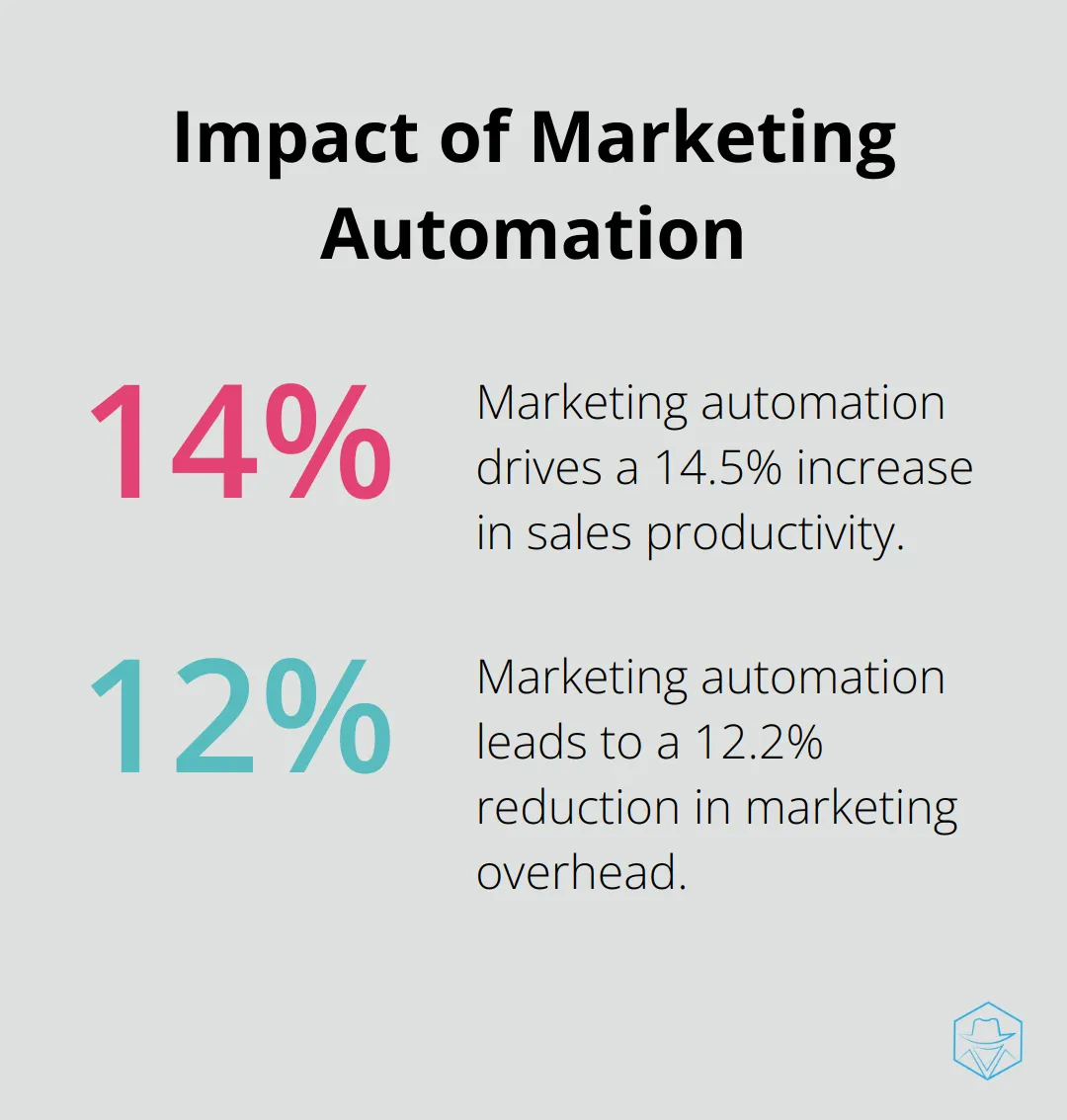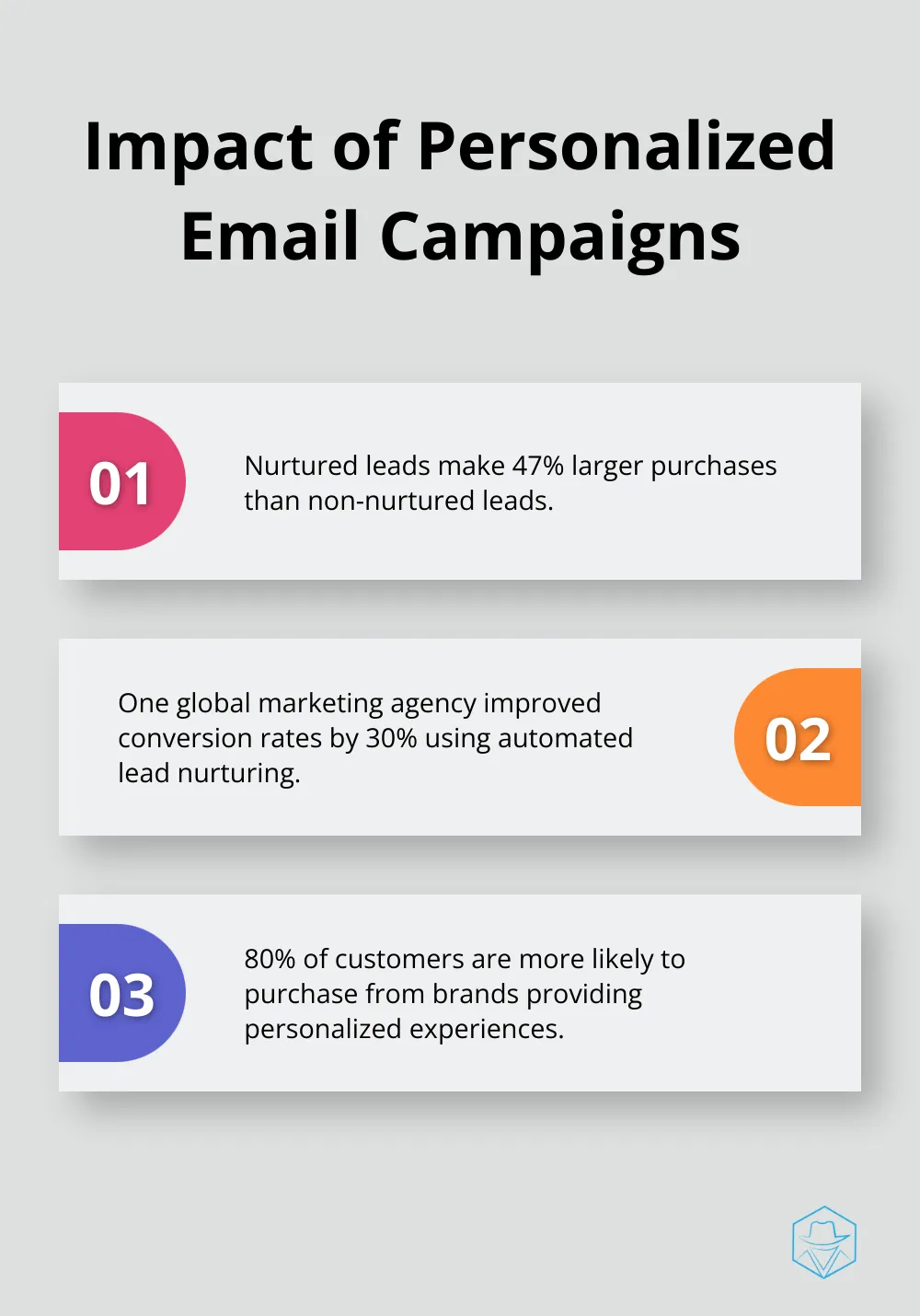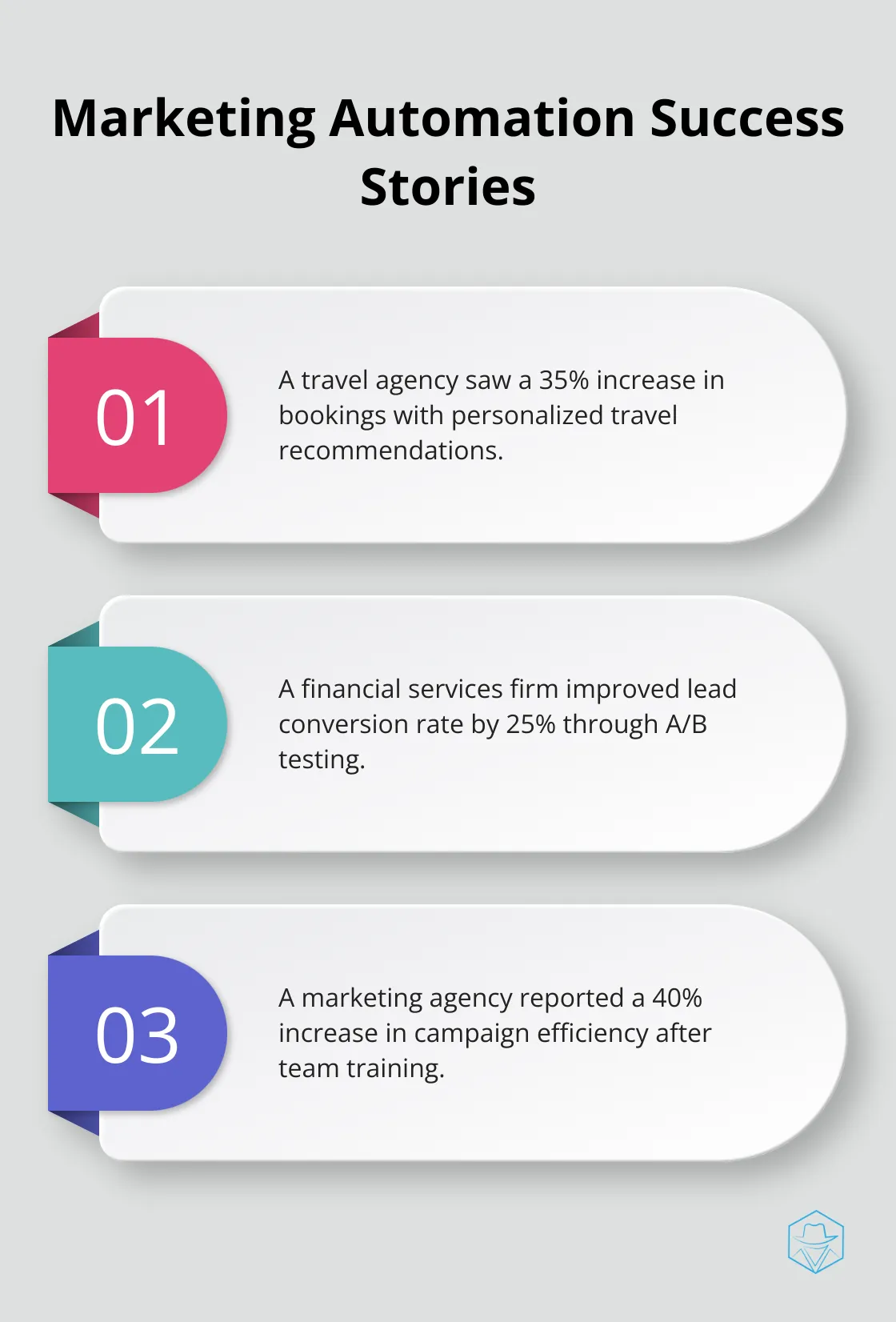Salesforce Marketing Automation: Boosting Efficiency

At Drop Cowboy, we’ve seen firsthand how marketing automation can transform businesses. Salesforce Marketing Automation stands out as a powerful tool in this landscape, offering a comprehensive suite of features to streamline marketing efforts.
This blog post will explore how Salesforce Marketing Automation boosts efficiency, from email campaigns to lead management. We’ll also share best practices to help you maximize its potential for your business.
What Is Salesforce Marketing Automation?
Defining the Power of Automation
Salesforce Marketing Automation revolutionizes how businesses handle their marketing efforts. This system automates repetitive marketing tasks, allowing companies to focus on strategy and creativity rather than manual processes.
Key Features That Drive Efficiency
Salesforce Marketing Automation packs features that streamline marketing operations. Email campaign management stands out, enabling businesses to create, schedule, and track email campaigns effortlessly. The lead scoring system automatically ranks potential customers based on their interactions, helping sales teams prioritize their efforts.
The customer journey mapping tool transforms how marketers visualize and optimize the entire customer experience (from first contact to purchase and beyond). Analytics and reporting capabilities provide deep insights into campaign performance, enabling data-driven decision-making.
Benefits Across Business Sizes
Salesforce Marketing Automation offers scalable benefits for businesses of all sizes. It levels the playing field for smaller businesses by automating tasks that would otherwise require a large team. Larger organizations can manage complex, multi-channel campaigns with ease.
A study by Nucleus Research found that marketing automation drives a 14.5% increase in sales productivity and a 12.2% reduction in marketing overhead. These numbers highlight the tangible benefits of implementing such a system.

Seamless Integration with Salesforce Ecosystem
One of the biggest advantages of Salesforce Marketing Automation is its integration with other Salesforce products. This creates a unified platform where marketing, sales, and customer service data flow seamlessly. For instance, when a lead interacts with a marketing email, that information becomes instantly available to the sales team in Salesforce CRM.
This integration extends to Salesforce’s AI capabilities, like Einstein Analytics. A fintech firm using Einstein Analytics increased their revenue forecast accuracy by 40% by automating projections. This kind of predictive power can give businesses a significant edge in staying ahead of market trends.
Alternatives and Complementary Solutions
While Salesforce offers robust features, other platforms provide unique capabilities that can complement or serve as alternatives to traditional email marketing automation. Drop Cowboy, for example, offers ringless voicemail and SMS integration, which can enhance your marketing strategy beyond what Salesforce provides. These tools can work alongside Salesforce or offer a different approach to reaching your audience, depending on your specific needs.
As we move forward, let’s explore the key features of Salesforce Marketing Automation in more detail, and how they can boost your marketing efficiency to new heights.
Unleashing Salesforce Marketing Automation’s Core Capabilities
Salesforce Marketing Automation offers a robust set of features that can significantly boost your marketing efficiency. This chapter explores these capabilities and how they transform marketing efforts.
Email Campaigns: A Powerhouse of Personalization
Salesforce’s email marketing tools elevate campaign management to new heights. The platform enables the creation of dynamic content that adapts based on recipient data, ensuring each email feels personalized. A study by the Annuitas Group found that nurtured leads make 47% larger purchases than non-nurtured leads (highlighting the importance of targeted, personalized email campaigns).
The platform also facilitates A/B testing of subject lines, content, and send times. This data-driven approach helps refine campaigns for maximum impact. One global marketing agency improved their conversion rates by 30% using Salesforce’s Pardot for automated lead nurturing.

Lead Scoring and Management: Precision at Its Best
Salesforce’s lead scoring system uses AI to analyze prospect behavior and assign scores based on their likelihood to convert. This allows sales teams to focus on the most promising leads, increasing efficiency and conversion rates.
The lead management features extend beyond scoring. They enable the setup of automated workflows that nurture leads based on their interactions. For instance, if a lead downloads a whitepaper, they can automatically enroll in a follow-up email sequence.
Customer Journey Mapping: A Visual Approach
The customer journey mapping tool in Salesforce Marketing Automation provides a visual representation of every touchpoint a customer has with your brand. This allows the identification of gaps in your marketing strategy and optimization of the customer experience at each stage.
You can set up triggers based on customer actions, ensuring timely and relevant communication. For example, if a customer abandons their cart, you can automatically send a reminder email with a discount code.
Analytics: The Power of Data-Driven Decisions
Salesforce’s analytics capabilities provide deep insights into marketing performance. You can track key metrics like open rates, click-through rates, and conversion rates in real-time. This allows for quick adjustments to improve campaign performance.
The platform’s AI-powered predictive analytics can forecast future trends based on historical data. A fintech firm using Salesforce’s Einstein Analytics increased their revenue forecast accuracy by 40%. This level of insight can help you stay ahead of market trends and make data-driven decisions.
Complementary Tools: Expanding Your Reach
While Salesforce offers comprehensive marketing automation features, specialized tools can complement these capabilities. For instance, Drop Cowboy’s ringless voicemail and SMS integration adds another dimension to your outreach strategy, allowing you to connect with customers through additional channels not covered by traditional email marketing.
The strategic use of these core features of Salesforce Marketing Automation creates more targeted, efficient, and effective marketing campaigns. The next chapter will explore best practices for implementing these powerful tools in your marketing strategy.
Maximizing Salesforce Marketing Automation
Set Clear, Measurable Objectives
Salesforce Marketing Automation users must define specific, measurable goals for their marketing efforts. Instead of vague aims like increasing engagement, set concrete targets such as boosting email open rates by 15% or reducing lead conversion time by 20%. These clear objectives will guide your strategy and provide benchmarks for success.
A B2B software company using Salesforce Marketing Automation set a goal to increase qualified leads by 30% in six months. They achieved this by creating targeted content for different stages of the buyer’s journey and automating lead nurturing sequences.
Master Audience Segmentation
Effective segmentation is key for personalized marketing. Use Salesforce’s robust data capabilities to segment your audience based on demographics, behavior, and engagement levels. A study by the Annuitas Group found that nurtured leads make 47% larger purchases than non-nurtured leads (highlighting the importance of targeted communication).
An e-commerce company increased their email click-through rates by 50% by segmenting their audience based on past purchase history and browsing behavior. They used this data to send personalized product recommendations, which significantly boosted sales.
Craft Compelling, Personalized Content
With your audience segments defined, create content that resonates with each group. Salesforce’s dynamic content features allow you to tailor emails, landing pages, and other marketing materials based on recipient data. According to Salesforce’s State of Marketing Report, 80% of customers are more likely to purchase from brands that provide personalized experiences.
A travel agency using Salesforce Marketing Automation saw a 35% increase in bookings by sending personalized travel recommendations based on customers’ previous destinations and search history.
Continuous Testing and Optimization
Marketing automation requires ongoing refinement. Test different elements of your campaigns regularly, from email subject lines to landing page layouts. Salesforce’s A/B testing capabilities make it easy to compare different versions and identify top performers.
One financial services firm improved their lead conversion rate by 25% through continuous A/B testing of their email campaigns. They tested various subject lines, call-to-action buttons, and email layouts to find the most effective combinations.
Invest in Team Training
To fully leverage Salesforce Marketing Automation, ensure your team receives thorough training on the platform. Salesforce offers extensive training resources, from online courses to in-person workshops. Companies that invest in comprehensive training see higher adoption rates and better results from their marketing automation efforts.
A marketing agency reported a 40% increase in campaign efficiency after implementing a structured training program for their team on Salesforce Marketing Automation. This included regular workshops, peer learning sessions, and hands-on projects.
While Salesforce offers powerful marketing automation capabilities, it’s worth exploring complementary tools to enhance your strategy. For instance, Drop Cowboy’s ringless voicemail and SMS integration adds another dimension to your outreach, allowing you to connect with customers through additional channels not covered by traditional email marketing.

Final Thoughts
Salesforce Marketing Automation has revolutionized how businesses approach their marketing efforts. This powerful tool automates repetitive tasks, provides deep analytics, and enables personalized customer journeys. Companies report significant improvements in marketing ROI, with some experiencing a 451% increase in qualified leads.
Strategic implementation remains essential to unlock the full potential of Salesforce Marketing Automation. Setting clear goals, segmenting audiences effectively, and creating personalized content will maximize the platform’s capabilities. The future of marketing automation in CRM systems looks promising, with advancements in AI and machine learning set to enhance efficiency and effectiveness further.
While Salesforce offers robust features, complementary tools can enhance your marketing strategy. Drop Cowboy’s innovative solutions (like ringless voicemail and SMS integration) work alongside Salesforce marketing automation to create a comprehensive outreach strategy. This combination allows businesses to reach their audience through multiple channels, potentially increasing engagement and conversion rates.
blog-dropcowboy-com
Related posts

April 17, 2025
Which SEO Apps Work Best for Shopify Stores?
Discover the best SEO apps for Shopify stores and boost your store’s visibility with top tools and strategies. Optimize your online presence now.

March 13, 2025
How to Master Marketing Automation Best Practices
Optimize your strategy with marketing automation best practices. Boost efficiency, engage customers, and increase conversion rates effectively.

April 17, 2025
How to Choose the Best Apps for Your Shopify Store
Find Shopify best apps with our expert guide. Boost sales and improve user experience with top app recommendations tailored for your store.

April 14, 2025
Is Triple Whale Worth It? An Honest Review
Explore an honest Triple Whale review. Learn if Triple Whale boosts e-commerce insights with features, pricing, and user experiences.

March 29, 2025
B2B Marketing Automation: Driving Business Growth
Boost business growth with marketing automation for B2B. Explore strategies, drive efficiency, and enhance ROI through automated marketing solutions.

April 24, 2025
How to Become a Marketing Automation Consultant
Master the course to become a consultant in marketing automation and help businesses achieve efficiency with proven strategies and expert insights.